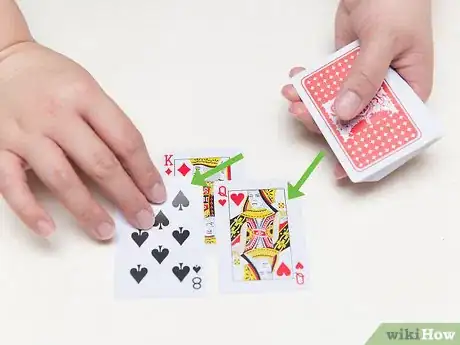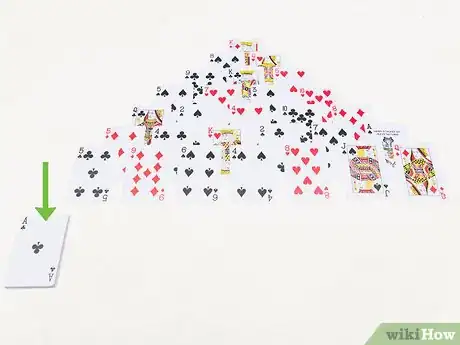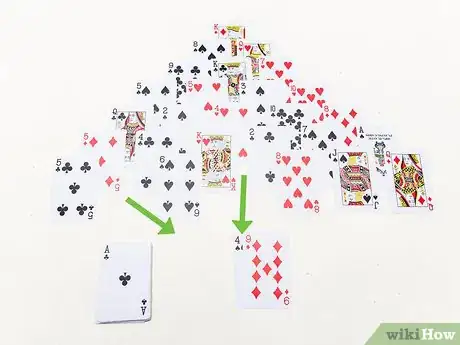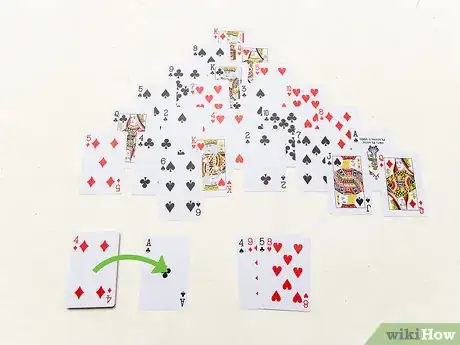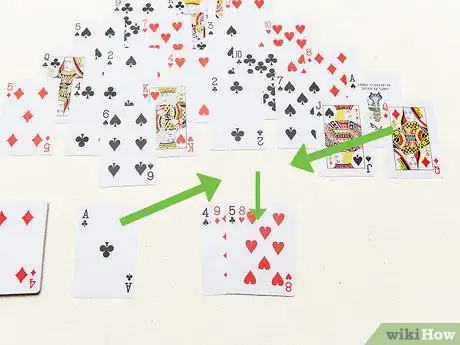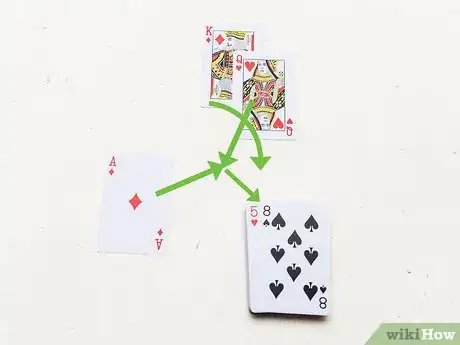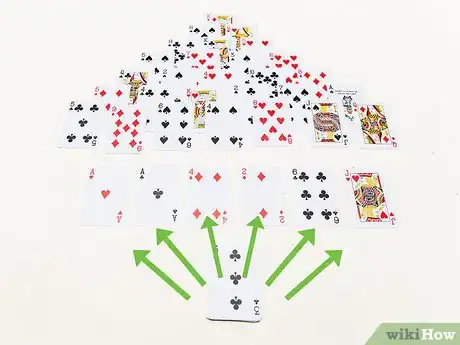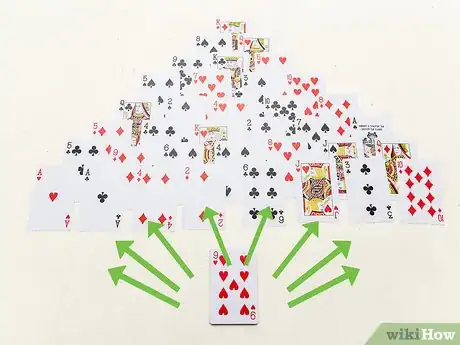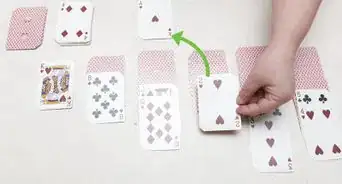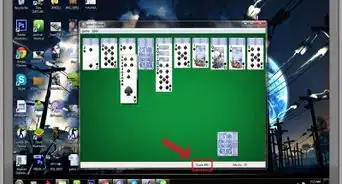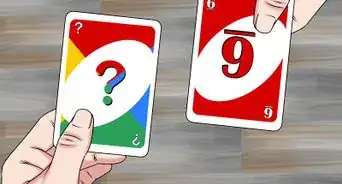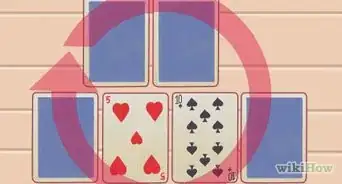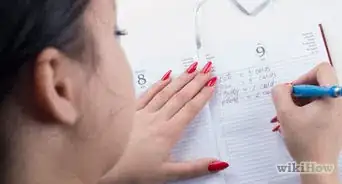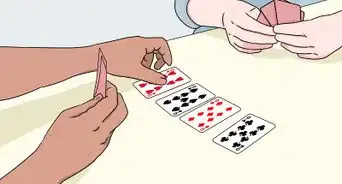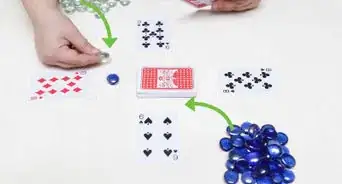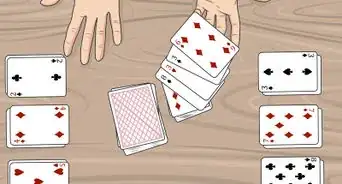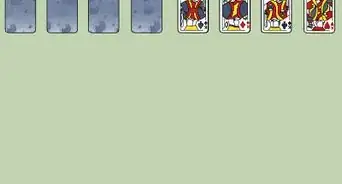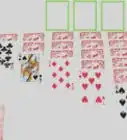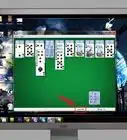This article was co-authored by wikiHow Staff. Our trained team of editors and researchers validate articles for accuracy and comprehensiveness. wikiHow's Content Management Team carefully monitors the work from our editorial staff to ensure that each article is backed by trusted research and meets our high quality standards.
This article has been viewed 85,316 times.
Learn more...
Pyramid solitaire is an exciting mix of classic solitaire and a simple adding game. Instead of a tableau that's a straight line, as in Klondike solitaire, pyramid solitaire features a triangle-shaped tableau made up of overlapping rows. Additionally, instead of building up each suit, the objective of pyramid solitaire is to match cards into pairs that add up to 13. Although there are a number of variations to the game, the core rules will stay the same regardless of your variation of choice.
Steps
Setting Up
-
1Shuffle the deck. Pyramid solitaire is typically played with a standard 52-card deck. Because suits don't matter in pyramid solitaire, a well-shuffled deck isn't vital for a good game, even with a brand new pack of cards.
-
2Deal a single card face up. This card will be the "top" of your pyramid tableau. In solitaire, a tableau is the large central layout and the main source for free cards. Unlike many other forms of solitaire, the pyramid tableau is completely face up.[1]Advertisement
-
3Make a new row with two more cards partially on top of the first. Place the two cards face up and side by side. Each of the two new cards should cover one lower quarter of the first card. The three cards should create a horizontally symmetrical triangle[2]
-
4Keep adding rows until you've dealt 28 cards total. Each additional row will have one more card than the one underneath it. The pyramid tableau is seven cards tall and has a base seven cards.[3]
- If your pyramid has a different number of rows or is not horizontally symmetrical, go backwards to figure out where you may have made a mistake while dealing.
-
5Place the remaining cards stacked face up and to the side. This stack of cards is called your stock. The stock should be neatly stacked so that only the top card is visible. Once the pyramid is fully formed and you've set your stock aside, you're ready to begin playing.[4]
Playing the Basic Game
-
1Find pairs of free cards that add up to 13. Place matched cards in a separate discard pile. This is the fundamental move in pyramid solitaire.
- Cards are only considered free when no other card is on top of them.
- Ace is low in this game and has a value of 1.
- Face cards are assigned special values: Jacks are 11, Queens are 12, and Kings are 13.
- Kings do not need a second card to form a match. Any free Kings can be removed on their own at any time.[5]
-
2Check for blocks. A certain percentage of hands are unwinnable, and learning to recognize them will save you some frustration. The main thing to look for are instances where all four of a particular card are part of a tableau below one or more of their matches.
- For example, if the very top of your pyramid is an ace and you have two Queens in your bottom row, one in your sixth row, and one in your fourth row, you have an unwinnable hand. At least one Queen is inherently impossible to match, making the top ace unreachable.[6]
- Many computerized versions of pyramid solitaire weed out the unwinnable games for you.
-
3Move the top stock card to the waste. The waste is a second stack of cards that is essentially the stock in reverse. Like the stock, the cards are oriented face up and the top card is free. You don't have to be stuck without a match to do this. In fact, it's prudent to move a playable card to the waste first. Doing so may reveal a second playable card underneath or otherwise give you more information for forming you strategy.[7]
-
4Feel free to match between the stock and the waste. Your aim is to match every card in the deck, and matches between the stock and waste are less likely to occur than matches to the tableau. You will have multiple chances to cycle through your stock to match with the tableau cards.
-
5Continue the game until one of the two end conditions are met. For basic pyramid solitaire, the game is over when:
- You have matched and removed every card in the tableau, stock, and waste. This means you have won the game.
- You have gone through the deck (moved all of the cards from the stock to the waste) three times. This means you have lost the game.[8]
Trying Different Variations
-
1Play with a set of reserve cards. Start the game off with an extra row of six free face-up cards in reserve. These cards may be played at any time throughout the game. Keep in mind that the reserve row isn't replenished; you only get six reserve cards per game.
- Try using a reserve row if you're having trouble winning the basic game.[9]
-
2Make tableaus of different shapes and sizes. As you build your pyramid, try spacing out the cards differently to create new and unique patterns. You don't necessarily need a perfect pyramid to create a playable game.
- You could also make a pyramid with essentially the same layout as the basic game but with an extra row, making the base eight cards wide.
-
3Limit yourself to a single pass through your stock. Only allow yourself to go through your stock once. Waste cards can never return to the stock, and the only way to go back through your waste is to match each top card. This adds a challenge to the game if you find yourself getting too good at it.[10] In addition to the extra difficulty, this variation has more unwinnable hands.
Community Q&A
-
QuestionHow many times can I go through the deck with the Windows Solitaire Collection games app?
 ChristopherTop AnswererYou move through each waste pile three times, then the entire deck changes up to three more times.
ChristopherTop AnswererYou move through each waste pile three times, then the entire deck changes up to three more times. -
QuestionCan I go through the stock more than once?
 ChristopherTop AnswererYes. Windows Solitaire Collection's rules for Pyramid do limit how many times you can go through the stock pile.
ChristopherTop AnswererYes. Windows Solitaire Collection's rules for Pyramid do limit how many times you can go through the stock pile.
References
- ↑ http://www.solitairecentral.com/rules/Pyramid.html
- ↑ http://www.solitairecentral.com/rules/Pyramid.html
- ↑ http://www.solitairecentral.com/rules/Pyramid.html
- ↑ http://www.solitairecity.com/Help/Pyramid.shtml
- ↑ http://www.solitairecity.com/Help/Pyramid.shtml
- ↑ http://www.solitairecentral.com/rules/Pyramid.html
- ↑ http://boardgames.about.com/od/solitaire/a/Pyramid-Solitaire-Strategy.htm
- ↑ http://www.solitairecentral.com/rules/Pyramid.html
- ↑ http://www.solitairecity.com/Help/Pyramid.shtml
About This Article
To play Pyramid Solitaire, first deal out 28 cards in a 7-tier pyramid, starting with a single card at the top and working your way to the bottom. Place the pile of leftover cards face up to the side to form the stock pile. The goal of the game is to match the cards into pairs that add up to 13. Aces are worth 1, Jacks are worth 11, Queens are worth 12, and Kings are worth 13. Only free cards, or cards that aren’t covered by another card, can be matched into pairs. When you make a match that adds up to 13, move those 2 cards off to the side to the discard pile. Any free Kings can be moved to the discard pile by themselves—they don’t need to be matched with another card. You can also use the top card on the stock pile to make matches. If you’re unable to use that card, move it off of the stock pile into a “waste” pile next to it to reveal the next top card on the stock pile. You can use the top card on either the original leftover pile or the waste pile to make matches, and you can make a match. Continue making matches and working your way through the pyramid until you’ve matched and discarded all of the cards in the pyramid, stock pile, and waste pile. If you get to a point where there are no more legal moves, the game is over. To learn more, including how to count the face cards in your deck, scroll down!


